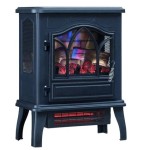How To Clean Gas Fireplace Glass
Gas fireplaces offer warmth and ambiance without the mess and intensive labor associated with traditional wood-burning fireplaces. However, even gas fireplaces require regular maintenance to ensure optimal performance and appearance. One crucial aspect of this maintenance is cleaning the glass panel, which can accumulate a white film or soot over time, obscuring the flames and detracting from the fireplace's aesthetic appeal. Understanding the causes of this buildup and the proper methods for cleaning the glass is essential for maintaining a clean and efficient gas fireplace.
The white film or soot that accumulates on gas fireplace glass is primarily caused by the combustion of natural gas or propane. While these fuels burn relatively cleanly, they can still produce byproducts such as sulfur, carbon, and moisture. These byproducts condense on the cooler surface of the glass, forming a layer of residue. The composition and thickness of this residue can vary depending on several factors, including the quality of the fuel, the fireplace's ventilation, and the frequency of use. Inadequate ventilation, for instance, can lead to a greater buildup of soot. Similarly, using lower-quality fuel with higher sulfur content can contribute to a more stubborn and noticeable white film.
Regular cleaning is not merely about aesthetics; it also contributes to the safety and efficiency of the gas fireplace. Excessive buildup on the glass can restrict airflow, potentially leading to incomplete combustion and the release of harmful gases into the room. Furthermore, a dirty glass panel can absorb more heat, potentially causing the glass to overheat and, in rare cases, crack. Therefore, incorporating regular glass cleaning into the gas fireplace maintenance routine is essential for both safety and optimal performance.
Preparing for Cleaning
Before commencing the cleaning process, it is imperative to ensure the fireplace is completely cool. Cleaning a hot or even warm glass surface can be hazardous, as it can cause burns and potentially damage the glass itself. Allow ample time for the fireplace to cool down entirely after its last use. This may involve waiting several hours, depending on the intensity and duration of the previous burn.
Once the fireplace is cool, the next step is to gather the necessary cleaning supplies. These typically include a non-abrasive glass cleaner specifically formulated for gas fireplaces, a soft cloth or microfiber towel, a spray bottle (if the cleaner is not already in one), a plastic scraper or putty knife, and a vacuum cleaner or brush. It is crucial to avoid using abrasive cleaners or scouring pads, as these can scratch the glass and permanently damage its surface. The selection of appropriate cleaning materials is critical for achieving effective cleaning without causing harm to the fireplace.
Protection of the surrounding area is also vital. Spread a drop cloth or old newspapers around the fireplace to protect the flooring or carpet from any drips or spills during the cleaning process. This step prevents potential staining or damage to the surrounding surfaces, ensuring the cleaning process remains contained and manageable.
Furthermore, familiarization with the fireplace's operation is crucial for safe glass removal and replacement. Consult the owner's manual for specific instructions on how to safely remove and reinstall the glass panel. Fireplace designs vary, and understanding the correct procedure is essential for avoiding damage to the glass or the fireplace itself. Some fireplaces have latches or clips that need to be released, while others may require the removal of screws. Incorrect removal or reinstallation can lead to cracks or breaks in the glass, necessitating costly repairs.
Cleaning the Glass
If the fireplace glass can be safely removed, it is generally recommended to do so. Removing the glass allows for easier access and a more thorough cleaning. Place the glass panel on a padded surface, such as a towel or blanket, to prevent scratching or breaking. If the glass cannot be removed, ensure the surrounding area is adequately protected from overspray.
Begin by using a dry brush or vacuum cleaner to remove any loose debris or soot from the glass surface. This initial step helps to prevent the cleaning solution from becoming contaminated with loose particles, which can make the cleaning process less effective. Pay particular attention to the edges and corners of the glass, where debris tends to accumulate.
Next, apply the gas fireplace glass cleaner to the surface, following the manufacturer's instructions. Spray a liberal amount of cleaner onto the glass, ensuring that all areas are covered. Allow the cleaner to sit for a few minutes, as directed, to dissolve the accumulated residue. This soaking period allows the cleaner to penetrate the stubborn buildup, making it easier to remove.
Using a soft cloth or microfiber towel, gently wipe the glass in a circular motion. Avoid applying excessive pressure, as this can scratch the glass. For stubborn areas, use a plastic scraper or putty knife to gently loosen the residue. Be careful not to gouge or scratch the glass with the scraper. The scraper should be held at a shallow angle and used to carefully lift the deposits without applying excessive force.
Once the glass is clean, use a clean, dry cloth to buff the surface until it is streak-free. This final step ensures a clear and polished finish, maximizing the visibility of the flames. Inspect the glass carefully to ensure that all residue has been removed and that no streaks or smudges remain.
If the glass has been removed, carefully reinstall it according to the manufacturer's instructions. Ensure that all latches, clips, or screws are properly secured to prevent air leaks. Double-check the installation to ensure that the glass is properly seated and that there are no gaps that could compromise the fireplace's safety or efficiency.
Addressing Stubborn Stains and Prevention
In some cases, the white film or soot on the gas fireplace glass may be particularly stubborn and difficult to remove with standard cleaning methods. This can occur if the residue has been allowed to accumulate for an extended period or if the fireplace is frequently used. When encountering such stubborn stains, a slightly more aggressive approach may be necessary, but it is crucial to proceed with caution to avoid damaging the glass.
One option is to create a paste using baking soda and water. Mix a small amount of baking soda with enough water to form a thick paste. Apply the paste to the stained areas and allow it to sit for several minutes. The baking soda acts as a mild abrasive, helping to loosen the residue. After the paste has sat for a sufficient amount of time, gently scrub the area with a soft cloth or sponge, rinsing thoroughly with water and drying with a clean cloth.
Another approach is to use a specialized gas fireplace glass cleaner specifically designed for removing tough stains. These cleaners often contain stronger solvents that can dissolve stubborn residue more effectively. However, it is essential to follow the manufacturer's instructions carefully and to test the cleaner on a small, inconspicuous area of the glass before applying it to the entire surface. This precautionary step helps to ensure that the cleaner does not damage the glass or leave any unsightly marks.
Prevention is always better than cure. Regular cleaning can significantly reduce the buildup of residue on the gas fireplace glass, making it easier to maintain and minimizing the need for harsh cleaning methods. Cleaning the glass every few weeks, or after every few uses, can prevent the buildup from becoming too severe. This proactive approach ensures that the glass remains clean and clear, providing optimal visibility of the flames and minimizing the risk of damaging the glass with aggressive cleaning techniques.
Additionally, ensuring proper ventilation in the room where the gas fireplace is located can help to reduce the accumulation of soot on the glass. Adequate ventilation allows for better airflow, which can prevent the buildup of combustion byproducts on the glass. Regularly check the fireplace's vent system to ensure that it is functioning properly and that there are no obstructions that could impede airflow.

Cleaning The Inside Of Gas Fireplace Glass Thrifty Decor Diy And Organizing

How To Clean Gas Fireplace Glass

How To Clean The Glass On Your Gas Fireplace

How To Clean The Glass On Your Gas Fireplace

Do Gas Fireplaces Need To Be Cleaned Direct Learning Center

How To Clean Fireplace Glass Wood And Gas Fireplaces Anita S Housekeeping

How Do I Clean My Fireplace Glass Center Kc

How To Clean Fireplace Glass

How To Clean Fireplace Glass Get Rid Of White On Gas

How To Clean The Glass On Your Gas Fireplace
Related Posts








